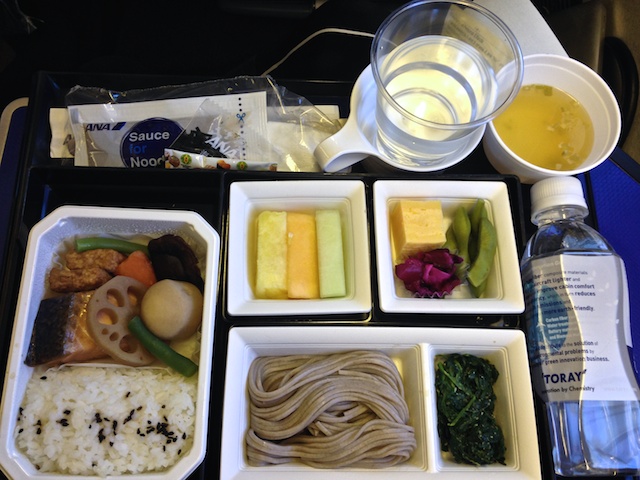In Between Days

We just took off from SFO; moving north over the city across the Golden Gate, hugging the coastline until it was time to hang a left. It was an odd feeling, to say the least. I’ve never flown over the Pacific (not even to Hawaii), so when the plane just kept heading West, over the expansive mass of blue, it finally hit me that we were going to Japan. I met Chris Fu from Anchor at the airport a little after 10 A.M. this morning and we had some time to shoot the breeze. Both of us were so busy this week between our regularly-scheduled workloads, the work we needed to get done before leaving (I’ve been battling a fever on top of that), and the craziness of the World Series, that neither of us put much thought into this trip. We simply woke up this morning, put a few things in a suitcase, and had our wives drop us off at the terminal. Considering it’s going to be about 80 degrees in Taipai and around 50 degrees in Sapporo, we did need to coordinate our wardrobes a bit, but I’m surprised by how nonchalant I’ve been about leaving. It feels like any other day, to me. Maybe that’s what happens, however, when you do this type of thing for a living: you start taking it for granted, perhaps.
Continually-rising whisky sales are something that the industry has been taking for granted lately, but there were a few reports this week that Diageo put the breaks on their distillery expansions due to a less-than-stellar quarterly sales report. One minute they were building new distilleries like the future of single malt was certain, the next minute they’re canceling investments in that very future. You’ll hear various reasons as to why this is happening (the end of Chinese political gift-giving, the cyclical nature of whisky, booms and busts, etc), but really what you need to look at to understand healthy growth is consumption. How many people are actually drinking the whisky they’re buying these days? I don’t mean collectors who buy bottles to save or to flip down the road, I mean: how many people actually finish a bottle of whisky once they open it? With new limited edition releases coming practically every week, and the number of guys I know who buy every single one of them, I’m wondering how many people can actually ingest and consume all that hooch? More than likely what happens is a stockpiling of partially-drunk bottles until space becomes an issue. Either it becomes time to throw a giant party, give the leftovers away, or listen to your wife’s demands that you stop buying more whisky. The excitement being generated by the whisky industry right now is contagious; we want to taste and to know and to experience everything we read about. Our eyes are bigger than our stomachs, however (or maybe our livers), and what really happens is: we buy, we open the bottle, we try a glass, and then we buy five more bottles before we’ve even put a dent in the last one. I know this because I am one of these people. But I also know this type of consumerism is happening on a larger scale because I communicate with thousands of others just like me on a daily basis.
My modest collection of bottles doesn’t bother me because I’m an equal opportunity drinker and eventually I’ll get around to finishing everything. I actually drink five times as much beer as I do whisky, and I drink ten times as much wine as I do beer. I usually do a beer after work (at work), a cocktail when I get home, a glass of wine with dinner, and maybe a shot of something after that. In my mind, that’s how the booze pyramid works: you’ve got all the food groups, which need to be consumed in certain proportions to maintain a balanced diet. I drink because I like to drink. This whole collectable, limited-edition whisky thing is just icing on my already-existing booze cake. But I know a lot of guys who drink only whisky because they’ve just discovered it. They didn’t drink that much of anything before and now—all of a sudden—they’re drinking whisky like it’s water. It’s become their life’s calling overnight. I have a feeling these drinkers have helped boost the whisky market over the last five years—the guys who are having fun with whisky just like they did following Phish around in college, or riding a skateboard in high school. It’s not a lifestyle they’re likely to maintain, however. It’s a fun phase that offers all kinds of hobbyistic (I just made that word up) pleasure, just like they felt when they were collecting baseball cards as a kid. Eventually all that shit goes into a shoebox, however, and life moves on into the next phase. You can’t depend on these drinkers to maintain this newly-found enthusiasm forever.
 The in-flight meal on ANA is awesomeMy question is: what happens when all these guys decide that the whisky party is over? I wrote an article for this blog a few years ago begging people not to fall into that trap. As Americans we can’t help it sometimes. One minute we’re eating pizza every night, the next minute we’re running five miles a day and eating gluten free. Then we injure ourselves due to unhealthy overexertion and it’s back to the couch for more pizza. We like to “get into” stuff and, like Drake, we go from zero to a hundred—real quick. When I write posts like “Drinking to Drink”, I’m hoping to remind people that booze is there to get drunk (and to get you drunk). If you don’t plan on drinking it, then maybe you shouldn’t be buying it (unless you’re investing, of course). I’ve noticed a trend at K&L lately when it comes to buyer’s remorse. Wine guys hardly ever complain about a purchase that failed to deliver. They’ll bring back corked or spoiled bottles, of course, but that’s what they’re supposed to do. When a bottle of whisky doesn’t live up to expectations, however, the whisky guys will sometimes mope about it for days—if not weeks! It’s like their whole life has been ruined by one bad experience, which cannot be repeated at any cost. I was trying to figure out why that was, why an underwhelming bottle of whisky made people more upset than a lackluster bottle of wine (even though wine is often just as expensive), and then one of my co-workers provided the answer: It’s because they don’t finish it all at once. The bottle continues to sit there on their bar until they decide what to do with the rest of it. Wine drinkers just throw their empty bottle in the recycling and move on. Bingo!
The in-flight meal on ANA is awesomeMy question is: what happens when all these guys decide that the whisky party is over? I wrote an article for this blog a few years ago begging people not to fall into that trap. As Americans we can’t help it sometimes. One minute we’re eating pizza every night, the next minute we’re running five miles a day and eating gluten free. Then we injure ourselves due to unhealthy overexertion and it’s back to the couch for more pizza. We like to “get into” stuff and, like Drake, we go from zero to a hundred—real quick. When I write posts like “Drinking to Drink”, I’m hoping to remind people that booze is there to get drunk (and to get you drunk). If you don’t plan on drinking it, then maybe you shouldn’t be buying it (unless you’re investing, of course). I’ve noticed a trend at K&L lately when it comes to buyer’s remorse. Wine guys hardly ever complain about a purchase that failed to deliver. They’ll bring back corked or spoiled bottles, of course, but that’s what they’re supposed to do. When a bottle of whisky doesn’t live up to expectations, however, the whisky guys will sometimes mope about it for days—if not weeks! It’s like their whole life has been ruined by one bad experience, which cannot be repeated at any cost. I was trying to figure out why that was, why an underwhelming bottle of whisky made people more upset than a lackluster bottle of wine (even though wine is often just as expensive), and then one of my co-workers provided the answer: It’s because they don’t finish it all at once. The bottle continues to sit there on their bar until they decide what to do with the rest of it. Wine drinkers just throw their empty bottle in the recycling and move on. Bingo!
Because whisky can remain fresh and drinkable for years after being opened, there’s no worry about finishing what we purchase. That’s a perk that most whisky drinkers enjoy, knowing that they can slowly nurse these bottles over a long period of time. I enjoy whisky’s durability as well, but ultimately I find that if I don’t consume the bottles on my bar within the first few weeks I’ll eventually tire of their presence. To me, wine is so much more fun because I get to open a new bottle every night! Each day when I wake up there’s a new adventure waiting for me later that evening. It’s a more healthy (not in the literal sense) way of drinking that’s more maintainable for my lifestyle. I open a bottle, I finish a bottle, and then I move on. The guys who obsess over every ounce, who pour their bottles into half-bottles over time to reduce the amount of oxygen, and who try to hold on to every drop like a hoarder who won’t throw away a movie ticket stub from fourteen years ago, they can't maintain the industry. I don’t think there were many people treating whisky that way ten years ago, and I don’t think many of those guys will be drinking whisky with the same ferocity ten years from now. Maybe they will be. I don’t know for sure, obviously. But I find that people who take this whole whisky thing too seriously tend to burn out and drive themselves insane rather than enjoy it. They’ll shop at K&L every week like crazy, for months at a time, then I’ll never see them again. Poof! They’re gone. That’s not good for the longevity of the whisky industry. I’m not looking to create temporary customers and max out their credit cards until they completely quit drinking in general. That type of hyper-consumerism will ultimately burn this new cycle of whisky enthusiasm out faster than we can ever predict. Nevertheless, this type of consumer is currently part of the new market. Will they remain loyal whisky drinkers into the next one, however? Will they come back to buy the same bottle again? That’s the million dollar question.
When I go on booze trips (like the one I’m currently on), I’m always looking for answers to these larger issues. What are other cultures doing with their whisky? How are they drinking it? Why are they drinking it? What are their expectations and what do they want from their whisky experience? I’ve got seven days to find out if either Taiwan or Japan can provide any insight. The more I go on these excursions, the less interested I am in how other countries are making spirits, and the more interested I become in how they’re drinking them. It’s the quality of the consumption of whisky that I think many Americans are missing out on these days, rather than the quality of the whisky itself.
-David Driscoll
